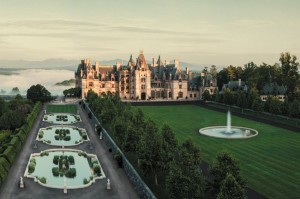I don’t like to abandon my home garden in spring, because there is far too much clean-up, cultivation and planning to do. But getting away is also a temptation, especially when the business of life threatens to spiral out of control and the spring weather is more wintery than vernal. In short, I just returned from a four day break in Asheville, North Carolina.
Ashville is a vibrant city of 89,000 people in the Blue Ridge Mountains of northwest North Carolina. It was founded in 1797, at the confluence of two Indian trails and developed slowly until railroad expansion linked it to the outside world in 1880. Commercial enterprise followed, and eventually Asheville, with its clean mountain air, also became a haven for people seeking relief from symptoms of consumption, now better known as tuberculosis.
At about the same time, in 1888, George Vanderbilt, one of the heirs to the enormous Vanderbilt mercantile fortune, visited Asheville with his mother. He liked it so much that he bought an enormous tract of land and commissioned the construction of what was to become the largest private house in America. The building process required the services of hundreds of locals and lasted from 1889 to 1895. The finished product, built to resemble a French chateau, was christened “Biltmore” and boasted 250 rooms. Vanderbilt filled those rooms with a king’s ransom worth of art, tapestries, woodwork and deluxe décor, no doubt enriching many impoverished European nobles, who gladly parted with ancestral treasures in exchange for ready cash. In 1930, when Asheville and the surrounding area were hard hit by the great Depression, Vanderbilt’s heirs opened the house to tourists. It has only grown in popularity since. Today, George Vanderbilt’s descendants still own the property and the Vanderbilt Company that runs its many enterprises.
I love art, architecture and American history, but I went to Biltmore for the gardens. These were designed by Frederic Law Olmsted, father of American landscape architecture and designer of Central Park, Prospect Park and numerous other notable landscapes. Biltmore was one of Olmsted’s last commissions and he is memorialized in a large portrait by American painter John Singer Sargent that hangs in a hall in the Biltmore house.
The designed landscape takes up only a fraction of the current Biltmore property, but it has all the elements that characterize Olmsted’s best work, including long vistas, winding drives and naturalistic plantings.
As befits an American chateau, the Biltmore features European-style formal elements including the evergreen-bounded Italian garden, which is comprised of three symmetrical water features that are home to aquatic plants and ornamental koi during the growing season. Asheville has had a cold spring, so the water features were just being filled when I saw them. I presume the koi overwinter elsewhere and had just returned.
I was also too early for the immaculately maintained formal rose garden, with its elegantly arranged beds of old and new roses. If the weather cooperates, it should be glorious in about a month’s time.
Hundreds of colorful tulips shone forth in the walled garden, a formal parterre, bounded by espaliered fruit trees. The display in this area is changed out as the seasons pass and I expect those tulips will soon make way for an artistic combination of late spring/early summer bedding plants.
Azaleas and rhododendrons are the prima donnas of the naturalistic Azalea Garden, which was a riot of pinks, reds, whites and oranges during my visit. Most of the rhodies were budded and waiting in the wings, which means that the whole area will continue on its colorful way throughout the spring. Two other naturalistic garden “rooms”, the Spring and Shrub Gardens, were alive with blooming lilacs, dogwoods, redbuds, Carolina Silver Bell trees, and fothergilla, not to mention Spanish bluebells, late daffodils and other spring favorites. Olmsted was all about reinforcing the spiritual, philosophical and healthful links between humans and nature and the less formal garden areas at Biltmore bring those associations to mind. You ramble thoughtfully, rather than striding purposefully, over the winding pathways that meander up and down the rolling slopes in the garden areas.
As part of his conservation focus, Olmsted recommended planned forestation of a portion of the estate, an idea that appealed to Vanderbilt. Sound forestry management practices were introduced and eventually Biltmore became home to a pioneering forestry school. Vanderbilt’s widow, Edith, eventually donated a forest tract of 86,000 acres to the Federal government. It is now the Pisgah National Forest and open to the public at no charge.
Impressive as Biltmore is, it is only the beginning of inspiring horticulture in Asheville. Next week we will explore the many large and small home gardens, as well as the city’s Botanical Garden. In the meantime, I will take all that Biltmore inspiration out in my home garden. I will never be George Vanderbilt, but I can at least introduce a little order into the current chaos on my small acreage.

